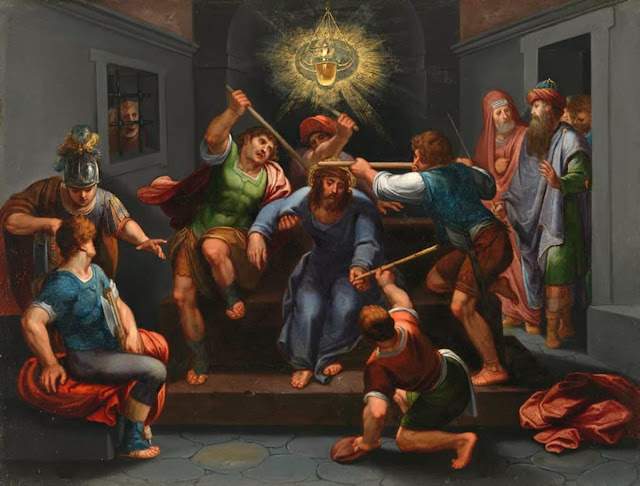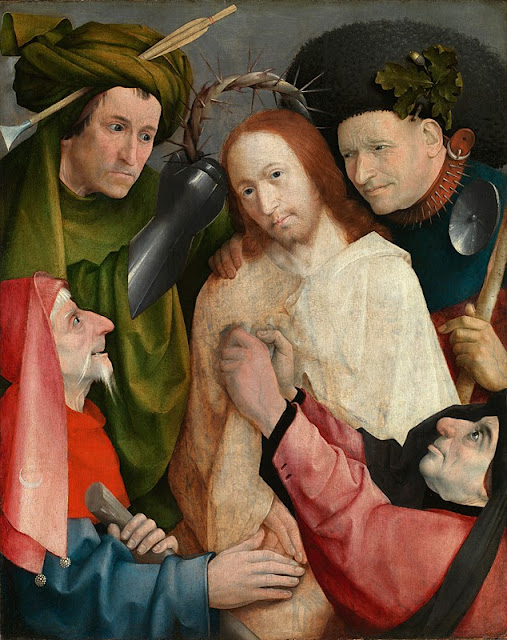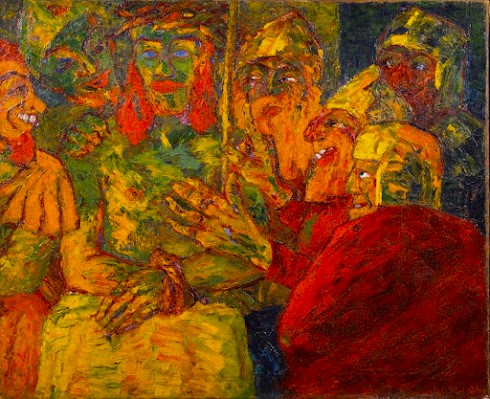 |
| Caravaggio, Crowning with thorns Italian, 1602 Vicenza, Banca Popolare di Vicenza |
"And the soldiers wove a crown out of thorns and placed it on his head, and clothed him in a purple cloak, and they came to him and said, “Hail, King of the Jews!” And they struck him repeatedly."
(John 19:2-3)
It has always seemed to me that the decades of the Rosary are structured in a very defined way. Like the most important intervals in the musical scale, the first, third and fifth decades of each series of Mysteries have always seemed to focus on the most important of the scenes that they bring to memory. In the Joyful Mysteries the third is the Birth of Jesus. In the Glorious Mysteries the third is the Descent of the Holy Spirit (Pentecost). It seems, therefore, odd that the third of the Sorrowful Mysteries is not the Crucifixion, but the Crowning with Thorns. For example, I can easily imagine a scenario in which the Crucifixion is the third, followed by the Descent from the Cross and the Entombment.
It has always seemed to me that the decades of the Rosary are structured in a very defined way. Like the most important intervals in the musical scale, the first, third and fifth decades of each series of Mysteries have always seemed to focus on the most important of the scenes that they bring to memory. In the Joyful Mysteries the third is the Birth of Jesus. In the Glorious Mysteries the third is the Descent of the Holy Spirit (Pentecost). It seems, therefore, odd that the third of the Sorrowful Mysteries is not the Crucifixion, but the Crowning with Thorns. For example, I can easily imagine a scenario in which the Crucifixion is the third, followed by the Descent from the Cross and the Entombment.
But, on reflection, I realized that the traditional list of the Sorrowful Mysteries actually does make sense. The Crowning with Thorns has something very important to teach us. For, the cruel mockery devised by the Roman soldiers is the inversion and perversion of the actual truth. In their twisted way they demonstrate the reality they did not recognize. Jesus is a king, greater than any they could imagine. His kingdom, as he told Pilate, is not of this world and it is achieved, not through dealing out violence as a conqueror, but through receiving the violence of his tormentors; not through self-aggrandizement, but through humiliation; not through subjecting others but in subjecting His human will to the Father’s divine will. It is, therefore, indeed the pinnacle of the Sorrowful Mysteries, that makes sense of the two preceding mysteries and of the two that follow it.
The iconography of the subject of the crowning with thorns is related to three other subjects that I discussed in 2012: the Mocking of Christ, the Ecce Homo and the Man of Sorrows. All three of these subjects, however, look at Jesus following the crowning. Here I will look at some pictures that show the action of the crowning.
The earliest image of the Crowning with Thorns comes from a Roman sarcophagus from the cemetery of Domitilla. Its depiction of the event is more symbolic than realistic. It depicts a serene Christ standing at ease, while a Roman soldier holds the crown of thorns above his head.
 |
| Sarcophagus with Scenes from the Passion of Christ Roman, c. 350 Vatican City, Vatican Museums, Museo Pio-Cristiano |
This serenity continued into the Middle Ages. Early images were often static, showing Christ seated, while two soldiers are posed as if attempting to force the thorns more deeply into his head. Often this is done by using long poles which the soldiers pull and push to drive the thorns in. The use of poles instead of hands or shorter clubs emphasizes how dangerous and cruel these thorns were
,%20c.%201365_Munich,%20BSB%20MS%20Clm%2023094,%20fol.%2050v_14.jpg) |
| Crowing with Thorns From a Psalter German (Magdeburg), c. 1265 Munich, Bayerisches Staatsbibliothek MS Clm 23094, fol. 50v |
,%20c.%201285-1290_Paris,%20Bibliotheque%20nationale%20de%20France_MS%20Nouvelle%20acquisition%20francaise%2016251,%20fol.%2035v.jpg) |
| Master Henri, The Crowning with Thorns From Livre d'images de Madame Marie Flemish (Hainaut), c. 1285-1290 Paris, Bibliotheque nationale de France MS NAF 16251, fol. 35v |
 |
The Crowning with thorns From Speculum humanae salvationis France (Alsace), 1370-1380 Paris, Bibliotheque nationale de France MS Latin 511, fol. 21v (detail) |
,%20c.%201425-1450_Paris,%20BNF_MS%20Francais%20376,%20fol.%20216r.jpg) |
| The Crowning with Thorns From Pelerinage du Jesu-Christ by Guillaume de Degulleville French (Rennes), c. 1425-1450 Paris, Bibliotheque nationale de France MS Francais 376, fol. 216r |
,%20Monastery%20Collection.jpeg) |
| The Crowning with Thorns |
Austrian, c. 1395-1405
Heiligenkreuz (AT), Monastery Collection
,%20Pilgrimage%20Church%20of%20Maria%20Waldrest.png) |
| The Crowning with Thorns Austrian, c. 1465 Mühlbachl (AT), Pilgrimage Church of Maria Waldrest |
However, beginning in the fourteenth century, the number of tormentors begins to increase, as does the level of violence. Whereas, in the earlier compositions, the two tormentors were posed in a balanced arrangement, with one on each side and Jesus in the middle, now they are posed more unevenly. One tormentor is frequently moved to stand or squat in front of Jesus. The scene becomes one of the entire theme of the mocking of Christ than just the isolated event of the crowning with thorns.
 |
| Giotto, The Mocking of Christ Italian, c. 1304-1308 Padua, Scrovegni/Arena Chapel |
 |
| Duccio, The Mocking of Christ Italian, c. 1308-1311 Siena, Museo dell'Opera del Duomo |
,%20Church%20of%20Saint%20Cyprian.jpeg) |
| Master of the Vigilius Legend, The Mocking of Christ Italian, c. 1395-1400 Sarnthein (IT), Church of Saint Cyprian |
 |
| Christ Crowned with Thorns Before Caiaphas From a Voyage d'outre mer by Sir John Mandeville Czech, c. 1410-1420 London, British Library MS Add. 24189, fol. 12r |
,%20Church%20of%20Saint%20John%20the%20Evangelist.jpeg) |
| The Mocking of Christ Italian, c. 1464 Mellaun (IT), Church of Saint John the Evangelist |
 |
| Master of the Freisinger Passion, The Crowning with Thorns German, c. 1480-1490 Munich, Bayerische Staatsgemaeldesammlungen, Staatsgalerie in der Burg zu Burghausen |
,%20Cathedral%20of%20the%20Assumption.jpeg) |
| The Mocking of Christ German, c. 1490-1510 Tirschenreuth (DE), Cathedral of the Assumption |
 |
| Master of the Dresden Prayerbook, The Crowning with Thorns and the Ecce Homo From the Breviary of Queen Isabella of Castille Flemish, c. 1497 London, British Library MS Additional 18851, fol. 103v |
Over time, painters increased the amount of difference between the face of the suffering Christ and the brutal, even bestial faces of the soldiers.
 |
| Circle of Rueland Frueauf, The Crowning with Thorns Austrian, c. 1500-1510 Regensburg, Museum der Stadt Regensburg |
 |
| The Crowning with Thorns German, c. 1500 Frankfurt-an-der-Oder, Church of Saint Gertuaud |
 |
| Hans Holbein the Elder, The Mocking of Christ From the Karlsheimer Altar German, 1502 Munich, Bayerische Staatsgemaeldesammlunger, Alte Pinakothek |
 |
| Hans Holbein the Elder, The Mocking of Christ German, c. 1504 Augsburg, Staatsgalerie im Schaezler-Palais |
 |
| Hans Schäufelin, The Mocking of Christ German, c. 1506-1507 Berlin, Gemäldegalerie dere Staatlichen Museen zu Berlin |
 |
| Christ Crowned with Thorns German, c. 1520 Institute of Material Culture of the Middle Ages and the Early Modern Period, Austria CC BY-NC-ND. |
,%20Church-%20Institute%20of%20Material%20Culture%20of%20the%20MA%20&%20the%20Early%20Modern%20Period,%20Austria%20-%20CC%20BY-NC-ND..jpeg) |
| Christ crowned with thorns German, c. 1525-1530 Heldsdorf (RO), Church |
 |
| Hans Schäufelin, The Mocking of Christ German, c. 1525-1530 Augsburg, Staatsgalerie im Schäzler-Palais |
,%20c.%201535-1540_Los%20Angeles,%20Los%20Angeles%20County%20Museum%20of%20Art.jpg) |
| Pierre Reymond, The Mocking of Christ French (Limoges), c. 1535-1540 Los Angeles, Los Angeles County Museum of Art |
 |
| Lambert van Noort, The Crowing with Thorns Flemish, Mid-16th Century Antwerp, Musée Royale des Beaux-Arts |
,%20Church%20of%20Our%20Lady.jpeg) |
| Hans Mielich, The Mocking of Christ German, c. 1530-1572 Ingolstadt (DE), Church of Our Lady |
,%20Harzog%20Anton%20Ulrich%20Museum.jpeg) |
| Jan Sadeler, The Mocking of Christ Flemish, c. 1570-1590 Braunschweig (DE), Harzog Anton Ulrich Museum |
 |
| Otto van Veen, The Mocking of Christ Flemish, c. 1590-1629 Munich, Bayerische Staatsgemäldesammlungen, Staatsgalerie Neuburg |
Beginning with the work of Hieronymous Bosch, the focus of the depictions of the Crowning with Thorns moved closer to the subject, closer to the figure of Jesus and of the faces of those who are torturing him. Sometimes this focus could be very close indeed, giving the viewer a sense of participation as a witness to the event.
 |
| Hieronymus Bosch, The Mocking of Christ Dutch, c. 1495-1500 El Escorial, Monasterio de San Lorenzo |
 |
| Hieronymous Bosch, Christ Crowned with Thorns Dutch, c. 1495-1500 London, National Gallery |
However, the earliest of these images still retain something of the static quality of the medieval images. They are more representations of cruelty and pain, than accurate pictures of these emotions.
Titian appears to have revised this, as he revised so many other images. In his several images of the crowning he introduces, through effects of light and shadow and motion, recognition of the pain that this act must have caused and of the violence of the attack.
 |
| Titian, The Crowning with thorns Italian, 1542 Paris, Musée du Louvre |
 |
| Titian, The Crowning with thorns Italian, c. 1572-1576 Munich, Bayerische Staatsgemäldesammlungen, Alte Pinakotek |
These elements were picked up on by his younger north Italian compatriot, Caravaggio and, through his followers, to the greater European context.
_Italian,%20c.1603_Vienna,%20KH%20MUs_3.jpg) |
| Caravaggio or a Follower, The Crowning with thorns Italian, c. 1602-1603 Vienna, Kunsthistorisches Museum |
 |
| Bartolomeo Manfredi, The Crowning with Thorns Italian, c. 1600-1622 Munich, Bayerische Staatsgemaeldesammlungen, Staatsgalerie im Neuen Schleissheim |
Artists who followed the shadowy style set by Caravaggio, who were called the Caravaggisti, began to use their shadowy compositions to study the effect of light in darkness. The subject of Christ's tortures, which took place at night, was an especially appropriate one to use to experiment with the effects of artificial light on the human and inanimate forms in their depictions. This was especially true of artists from northern Europe.
 |
| Leonello Spada, The Mocking of Christ Italian, c. 1615 Rome, Palazzo Barberini |
 |
| Valentin de Boulogn, The Mocking of Christ French, c. 1616-1617 Munich, Bayerische Staatsgemaeldesammlungen, Alte Pinakothek |
 |
| Anthony van Dyck, The Crowning with thorns Flemish, c. 1618-1620 Rome, Galleria Corsini |
 |
| Anthony van Dyck, The Crowning with thorns Flemish, c. 1618-1620 Madrid, Museo Nacional del Prado |
 |
| Hendrick Terbrugghen, The Mocking of Christ Dutch, 1620 Copenhagen, Statens Museum for Kunst |
 |
| Gerrit van Honthorst, Christ Crowned with Thorns Dutch, c. 1620 Los Angeles, J. Paul Getty Museum |
 |
| Valentin de Boulogne, The Crowning with thorns French, c. 1627-1628 Munich, Bayerische Staatsgemäldesammlungen, Alte Pinakotek |
 |
| Jan Willem Janssens Flemish, c. 1650 Ghent, Museum voor Schone Kunsten |
 |
| Jan Willem Janssens, The Mocking of Christ Flemish, c. 1650 Toilouse, Musée des Augustins |
 |
| Samuel van Hoogstraten, Christ Crowned with Thorns Dutch, 1657 Munich, Bayerische Staatgemäldesammlungen, Alte Pinakothek |
 |
| David Teniers the Younger, The Mocking of Christ Flemish, c. 1660-1690 Munich, Bayerische Staatgemäldesammlungen, Staatsgalerie Neuburg |
 |
| Jacob van Oost the Elder,The Mocking of Christ Flemish, 1661 Bruges, Groeninge Museum |
 |
| Carlo Antonio Bussi, The Mocking of Christ Italian, 1690 Voecklabruck (AT), Church of Saint Agidius |
 |
| Francesco Trevisani, The Mocking of Christ Italian, c. 1696 Rome, Galleria Colonna |
It was this heightened, emotionally charged image that continued to be transmitted within European art, down to the end of the nineteenth century and into the twentieth.
 |
| James Tissot, The Crowning with Thorns French, c. 1886-1894 New York, Brooklyn Museum |
 |
| Emil Nolde, The Mocking of Christ German, 1909 Berlin, Brucke-Museum |
,%20New%20York-%20ADAGP,%20Paris.jpg) |
| Georges Rouault, Christ Mocked by Soldiers French, 1932 New York, Museum of Modern Art © 2024 Artists Rights Society (ARS), New York- ADAGP, Paris |
© M.
Duffy, 2013. Revised and expanded, with additional images 2024.
* Some examples for the similarity of style that come to mind are:
Ernst Ludwig Kirchner
Emil Nolde
One could make a case that the flattened, jagged forms in German Expressionism are only a more recent occurrence of forms that are native to German art, jazzed up with some quotations from African art like those in some of the early works of Picasso.
Scripture texts in this work are taken from the New American Bible,
revised edition © 2010, 1991, 1986, 1970 Confraternity of Christian Doctrine,
Washington, D.C. and are used by permission of the copyright owner. All Rights
Reserved. No part of the New American Bible may be reproduced in any form
without permission in writing from the copyright owner.
,%20Church%20of%20Our%20Lady.jpeg)



_German,%201919_New%20Haven,%20Yale%20University%20Art%20Gallery_Page_1.jpg)
No comments:
Post a Comment